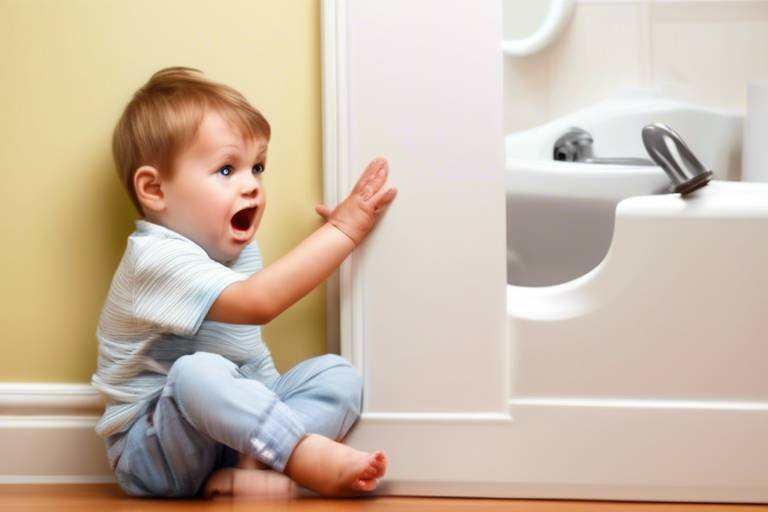Homeschool Health: Encouraging Physical Activity in Your Child
In today's fast-paced world, where screens dominate our lives, encouraging physical activity in children can feel like an uphill battle. As parents, especially those who homeschool, it’s crucial to foster a love for movement in our children. Why is this so important? Well, physical activity isn't just about keeping fit; it's about nurturing a holistic sense of well-being. When children engage in regular exercise, they not only enhance their physical health but also boost their mood, improve their focus, and develop social skills.
Imagine your child bursting with energy, ready to take on the world after a fun-filled day of movement. It’s not just a dream; it’s a reality you can create! By integrating physical activity into your homeschool routine, you are setting the stage for a healthier lifestyle that can last a lifetime. This article will provide you with practical strategies to make physical activity an enjoyable part of your child’s daily life.
Physical activity is essential for children's physical, mental, and emotional well-being. The benefits are numerous and profound. Engaging in regular exercise helps improve mood, reduces anxiety, and enhances focus. Think of it as a magical potion that can transform your child's day from drab to fab! Studies show that children who are physically active tend to perform better academically, as exercise increases blood flow to the brain, sharpening their cognitive abilities.
Moreover, being active lays the foundation for healthy habits that can carry into adulthood. It’s not just about today; it’s about equipping our children with the tools they need for a vibrant future. So, how can we, as homeschooling parents, create an environment that encourages our kids to move?
Establishing a daily routine that incorporates physical activity can help children develop healthy habits. A well-structured day can be a game changer! Consider including a mix of activities that cater to your child's interests. For instance, if your child loves dancing, why not start the day with a dance-off? Or, if they’re more inclined toward sports, set aside time for some backyard soccer or basketball.
Here’s a simple example of how you can structure a day:
| Time | Activity |
|---|---|
| 8:00 AM | Morning Stretch and Yoga |
| 10:00 AM | Outdoor Play (Biking, Running) |
| 1:00 PM | Dance Break |
| 3:00 PM | Sports Practice (Soccer, Basketball) |
This structure not only keeps your child active but also gives them something to look forward to throughout the day. Remember, consistency is key!
Engaging children in fun and enjoyable activities can motivate them to stay active. Think of physical activity as a treasure hunt—when it's fun, they won't even realize they’re exercising! Here are some ideas:
- Obstacle courses in the backyard.
- Treasure hunts that require running and searching.
- Family dance parties where everyone can show off their moves.
- Yoga sessions with fun themes like animals or superheroes.
These activities can be easily integrated into the homeschool day, making movement a natural part of their learning experience.
Exploring nature through hiking, biking, or playing in parks can be a fantastic way to promote physical activity. Nature is like a giant playground waiting to be explored! Not only does it provide a change of scenery, but outdoor activities also encourage children to appreciate the environment. Consider planning weekly adventures where you can hike local trails, ride bikes in the park, or even just play tag in your backyard. The fresh air and sunshine will do wonders for their mood and energy levels!
When outdoor activities aren’t feasible, indoor exercises can keep children active. Think of it as bringing the gym to your living room! You can create an indoor workout routine that includes:
- Jumping jacks
- Bodyweight exercises like squats and push-ups
- Interactive fitness videos available online
These exercises can be done anytime, ensuring physical activity year-round. The key is to make it fun and engaging!
Setting achievable goals can encourage children to stay active and motivated. This could be as simple as aiming to run a certain distance or mastering a new dance move. Parents can help their children set and track fitness goals using charts or apps. Celebrate their achievements, no matter how small, to keep them motivated!
Technology can be a powerful tool in promoting physical activity. With the right resources, you can turn screen time into active time! There are numerous apps and online platforms designed to make exercise fun and engaging for children.
Interactive games and virtual classes can provide a fun way for children to exercise. Platforms like Just Dance or Fitness Blender offer engaging workouts that kids will love. These games encourage movement while keeping kids entertained, turning exercise into a game rather than a chore.
Using fitness trackers can help children understand their activity levels. These devices can motivate kids to reach their physical activity goals by tracking steps, active minutes, and even calories burned. It adds a layer of excitement and competition, making them more likely to stay active.
Q: How much physical activity do children need?
A: Children should aim for at least 60 minutes of moderate to vigorous physical activity each day.
Q: What are some indoor activities for rainy days?
A: Indoor activities can include dance parties, yoga, and obstacle courses made with household items.
Q: How can I make physical activity more enjoyable for my child?
A: Incorporate games, challenges, and family activities to make exercise feel like fun rather than a chore.

Understanding the Importance of Physical Activity
Physical activity is not just a way to burn off energy; it's a vital component of a child's overall development. Think of it as the fuel that powers their growth, both physically and mentally. Engaging in regular exercise can lead to a myriad of benefits that extend beyond mere physical fitness. For starters, it plays a crucial role in enhancing mood and reducing feelings of anxiety and depression. When kids are active, their bodies release endorphins, often referred to as the "feel-good" hormones, which can lift their spirits and make them feel happier.
Moreover, physical activity can significantly improve focus and cognitive function. Have you ever noticed how a quick run or a game of tag can help clear your mind? Well, it's not just you! Studies have shown that children who engage in regular physical activity tend to perform better academically. This is because exercise increases blood flow to the brain, which can enhance learning and memory. It's like giving their brains a refreshing drink of water!
In addition to boosting mood and focus, physical activity also contributes to better overall health. Regular exercise helps strengthen the heart, lungs, and muscles, making children more resilient against illnesses. It can also help maintain a healthy weight, which is increasingly important in today's world where sedentary lifestyles are the norm. By incorporating physical activity into their daily routine, parents can help their children develop lifelong habits that promote well-being.
But the benefits of physical activity don’t stop there. It can also improve social skills. When children participate in team sports or group activities, they learn valuable lessons about cooperation, teamwork, and communication. These experiences can help them build lasting friendships and improve their ability to work with others. So, not only are they getting fit, but they are also learning how to navigate social situations!
To sum it up, the importance of physical activity in a child's life cannot be overstated. Here’s a quick recap of the key benefits:
- Improved Mood: Physical activity boosts endorphins, enhancing happiness.
- Better Focus: Exercise increases blood flow to the brain, aiding cognitive function.
- Overall Health: Regular activity strengthens the body and helps maintain a healthy weight.
- Enhanced Social Skills: Team sports foster cooperation and communication among peers.
Encouraging your child to be active is one of the best gifts you can give them. It's about more than just staying fit; it's about nurturing their minds, bodies, and spirits. So, let's dive into how you can create an engaging and active homeschool environment!

Creating a Structured Routine
Establishing a structured routine is like laying down the tracks for a train; it keeps everything on course and moving smoothly. When it comes to physical activity, having a daily schedule that includes exercise can significantly enhance your child’s health and happiness. Think about it: just as we wouldn’t want to take a road trip without a map, children thrive when they know what to expect each day. By incorporating physical activity into their routine, you’re not just promoting fitness; you’re also fostering a sense of security and stability in their lives.
To create a balanced schedule that includes exercise, start by identifying the best times during the day for your child to engage in physical activity. This could be in the morning before lessons, during lunch breaks, or even in the late afternoon. The key is consistency. For instance, if you decide that 10 AM is the time for a quick workout, stick to it! Here’s a simple example of how you might structure a day:
| Time | Activity |
|---|---|
| 8:00 AM | Breakfast |
| 9:00 AM | Math Lesson |
| 10:00 AM | Physical Activity (e.g., Yoga or Dance) |
| 11:00 AM | Science Lesson |
| 12:00 PM | Outdoor Play |
| 1:00 PM | Lunch |
| 2:00 PM | Reading Time |
| 3:00 PM | Structured Exercise (e.g., Sports Practice) |
In this example, you can see how integrating physical activities into the schedule allows for a balanced approach to learning and fitness. It's not just about squeezing in exercise; it's about making it a natural part of the day. Encourage your child to look forward to these activities by varying them. One day it could be a fun dance-off in the living room, and the next, it could be a mini obstacle course in the backyard. The more diverse the activities, the more likely they are to stay engaged and excited.
Moreover, don’t underestimate the power of flexibility. Life happens, and sometimes your carefully laid plans may need a little tweaking. If the weather turns gloomy, or if your child is feeling under the weather, adapt the routine accordingly. The goal is to keep moving and to find joy in physical activity, even if it means switching from an outdoor game to a cozy indoor workout. Remember, the best routine is one that fits your family's unique lifestyle and keeps everyone happy and healthy.
By creating a structured routine that includes physical activity, you're not only promoting a healthier lifestyle but also teaching your children the importance of balance. They’ll learn that fitness is not a chore but a fun part of their everyday life, which can lead to lifelong habits of health and wellness. So, grab that planner and start mapping out a routine that works for your family. You might just find that the journey is as rewarding as the destination!

Incorporating Fun Activities
When it comes to keeping your child active, the key is to make it fun! Let’s face it, children are more likely to engage in physical activities if they’re enjoyable rather than a chore. Think of physical activity as a treasure hunt—if it’s exciting, they’ll want to join in! Here are some creative ways to incorporate fun activities into your homeschool routine:
First, consider turning exercise into a game. You can create obstacle courses in your backyard or living room using pillows, chairs, and other household items. This not only keeps them moving but also sparks their creativity as they navigate through their own designed course. You can even time them to add a competitive edge, which can be a fun challenge!
Another great idea is to include dance breaks throughout the day. Dancing is an excellent way for kids to express themselves and get their heart rates up. You can play their favorite songs and have a mini dance party. Not only will this lift their spirits, but it also helps improve their coordination and balance. Plus, who doesn’t love dancing around the house?
Sports are another fantastic avenue to explore. Whether it’s soccer, basketball, or even a simple game of tag, the options are endless. You can set up a small basketball hoop in the driveway or kick a soccer ball around the yard. The beauty of sports is that they can be played alone or with friends, allowing for social interaction, which is essential for emotional health.
Don’t forget about nature walks! Incorporating physical activity doesn’t always mean structured exercise. A simple stroll in the park or a hike can be invigorating. Encourage your kids to explore their surroundings; maybe they can collect interesting leaves or stones along the way. This not only keeps them active but also connects them with nature, which has its own set of health benefits.
Lastly, consider using technology to your advantage. There are countless apps and online platforms that offer interactive fitness games. These can make exercise feel like playtime rather than a workout. Kids can dance, jump, and even compete with friends virtually, turning physical activity into a social event.
In summary, the key to encouraging physical activity in your homeschool environment is to make it fun. By incorporating games, sports, dance, outdoor adventures, and technology, you can create a dynamic routine that keeps your child engaged and active. Remember, the more they enjoy it, the more likely they are to participate!
Q: How can I motivate my child to be more active?
A: Try to incorporate fun activities into their routine, such as games, sports, and dance parties. Make it a family affair to encourage participation!
Q: What if my child prefers indoor activities?
A: Indoor activities like dance, yoga, or even interactive fitness games can keep them moving. Get creative with household items to create fun exercises!
Q: How much physical activity should my child get each day?
A: Ideally, children should aim for at least 60 minutes of physical activity each day. This can be broken down into smaller segments throughout the day.

Outdoor Adventures
When it comes to keeping our kids active, there’s nothing quite like the great outdoors! Outdoor adventures not only promote physical activity but also provide a myriad of benefits for children's overall health and development. Think about it: the fresh air, the sounds of nature, and the thrill of exploring new places can ignite a sense of wonder and excitement in your child. Whether it's a simple walk in the park or a challenging hike up a mountain, outdoor activities can transform exercise into an exhilarating experience.
One of the most significant advantages of outdoor adventures is the opportunity for children to connect with nature. This connection can lead to a greater appreciation for the environment and an understanding of the importance of preserving it. Plus, when kids are outside, they’re not just moving their bodies; they’re also using their imaginations. They can pretend to be explorers, scientists, or even superheroes on a mission, which makes physical activity feel more like play than work.
So, what are some fantastic outdoor activities you can incorporate into your homeschool routine? Here are a few suggestions:
- Hiking: Find local trails and embark on family hikes. This not only builds endurance but also allows for family bonding time.
- Biking: Riding bikes around the neighborhood or on designated bike paths is a fun way to get the heart pumping.
- Playing Sports: Grab a ball, a bat, or a frisbee and head to the nearest park. Engaging in sports like soccer, basketball, or even just a friendly game of catch can keep kids active.
- Nature Scavenger Hunts: Create a list of items for your kids to find in nature, turning a walk into an exciting adventure.
Moreover, outdoor adventures can also enhance social skills. When children play in groups, they learn teamwork, communication, and leadership skills—all while having fun! It's a win-win situation. So, next time you're planning your homeschool curriculum, consider dedicating time for outdoor activities. Not only will your children stay active, but they'll also develop a love for nature and learn valuable life skills along the way.
In conclusion, the outdoors offers a treasure trove of opportunities for physical activity that can enrich your child's life. So, lace up those shoes, grab a water bottle, and get ready to explore the wonders that await just outside your door!
Q1: How often should my child engage in outdoor activities?
A1: Ideally, children should aim for at least 60 minutes of physical activity each day, which can include outdoor play.
Q2: What if the weather is bad?
A2: There are plenty of indoor activities that can mimic outdoor adventures, such as obstacle courses or dance parties. However, if it’s safe, consider bundling up for some fresh air!
Q3: How can I make outdoor activities more engaging?
A3: Incorporate games, challenges, or themed adventures to keep things exciting. For example, turn a hike into a treasure hunt!

Indoor Exercises
When the weather isn't cooperating or outdoor play isn't an option, can be a lifesaver for keeping your child active and engaged. The beauty of indoor activities is that they can be just as fun and effective as outdoor ones. Think of your living room as a playground where imagination and movement collide! With a little creativity, you can turn any space into a mini gym.
One great way to start is by incorporating some simple exercises that require minimal space and equipment. For instance, jumping jacks, push-ups, and squats can all be done in a small area. These exercises not only get the heart rate up but also help build strength and endurance. You can even create a fun routine by combining different exercises into a circuit. Imagine your child jumping from one activity to the next like a superhero on a mission!
Additionally, you can use household items as exercise tools. For example, cushions can serve as balance beams, and chairs can be used for step-ups or tricep dips. This approach not only makes exercising more accessible but also encourages creativity. It’s like turning your home into a fitness adventure land!
To make it even more exciting, consider setting up a mini obstacle course in your living room or hallway. Use furniture, toys, and other objects to create challenges that your child can navigate through. This can include crawling under tables, jumping over pillows, or even balancing on a line of tape. Not only does this keep them physically active, but it also sharpens their problem-solving skills as they figure out how to tackle each obstacle.
And let's not forget about the power of dance! Put on some upbeat music and let your child dance like nobody's watching. Dancing is a fantastic way to get moving while having a blast. You can even join in and turn it into a family dance party. This not only promotes physical activity but also strengthens family bonds. Remember, the goal is to make exercise enjoyable, so don’t hesitate to get silly and have fun!
For those who prefer a more structured approach, there are plenty of online resources and apps that offer guided workouts for kids. These can range from yoga sessions to high-energy cardio workouts. YouTube has a plethora of channels dedicated to children’s fitness, making it easy to find something that suits your child's interests. Just imagine them following along with a fun instructor, getting fit while laughing and smiling!
Incorporating indoor exercises into your child's routine not only helps them stay active but also instills a love for fitness that can last a lifetime. By turning exercise into a game, you help them see physical activity as something enjoyable rather than a chore. So, roll out those yoga mats, crank up the music, and let the indoor fun begin!
Q: How much indoor exercise should my child get each day?
A: Aim for at least 30 minutes of physical activity each day. This can be broken up into shorter sessions throughout the day to keep it fun and engaging.
Q: What if my child doesn't like traditional exercises?
A: Focus on activities they enjoy! Dancing, playing games, or even helping with household chores can be great ways to keep them moving.
Q: Are there any specific indoor activities that are best for young children?
A: Yes! Activities like obstacle courses, dance parties, and interactive games can be particularly engaging for younger kids.
Q: How can I encourage my child to be more active indoors?
A: Make it a family affair! Join in on the fun, set challenges, and celebrate achievements to keep your child motivated and excited about being active.

Setting Goals and Challenges
Setting goals and challenges is a fantastic way to encourage your child to stay active and engaged in physical activities. Think of it as giving them a treasure map, where the "X" marks the spot of their achievements! When children have clear, achievable targets, they are more likely to stay motivated and excited about their fitness journey. Start by discussing with your child what they enjoy doing. Is it dancing, running, or maybe even martial arts? Tailoring goals around their interests will not only make the process enjoyable but also foster a sense of ownership over their fitness.
To make the goal-setting process effective, consider using the SMART criteria—Specific, Measurable, Achievable, Relevant, and Time-bound. For instance, instead of saying, "I want to exercise more," a SMART goal could be, "I will ride my bike for 30 minutes every Saturday morning." This way, your child knows exactly what they need to do and when to do it. You can even create a fun chart to track their progress, which adds a visual element to their achievements. Every time they reach a goal, celebrate it! This could be as simple as a high-five or a special treat, reinforcing their hard work.
Another effective strategy is to introduce friendly challenges. These can be family-oriented, encouraging everyone to participate and stay active together. For example, you could set a challenge to see who can complete the most steps in a week or who can learn a new sport together. By turning fitness into a family affair, you not only promote physical activity but also strengthen your family bonds. Remember, the key is to keep it light-hearted and fun—if it feels like a chore, your child might lose interest quickly.
To further enhance this process, consider keeping a fitness journal. This can be a simple notebook where your child logs their activities, feelings, and progress. Writing down their experiences can help them reflect on what they enjoy and what they’d like to improve. Plus, it provides a tangible record of their accomplishments, which can be incredibly motivating! Encourage them to set new challenges regularly, whether it's trying a new sport, increasing their exercise duration, or even participating in a local fun run.
In summary, setting goals and challenges is not just about physical activity; it's about building confidence, resilience, and a lifelong love for movement. By engaging in this process, you’re equipping your child with essential life skills that extend beyond fitness. So, why not start today? Grab a piece of paper, brainstorm some fun goals together, and watch as your child thrives in their journey towards a healthier, more active life!
- How do I know if my child's goals are appropriate? It's essential to consider your child's age, interests, and current fitness level. Goals should be challenging yet achievable to maintain motivation.
- What if my child doesn't want to participate in physical activities? Try to find activities that align with their interests. Sometimes, introducing new sports or games can spark their enthusiasm.
- How often should we set new goals? Regularly reassess goals every few weeks or months, depending on your child's progress. This keeps things fresh and exciting!
- Can technology help in setting fitness goals? Absolutely! Fitness apps and trackers can provide insights and reminders, making goal-setting interactive and fun.

Utilizing Technology for Physical Activity
In today's digital age, technology is not just a distraction; it can be a powerful ally in promoting physical activity among children. With the right tools and resources, parents can turn screen time into an opportunity for movement and exercise. Imagine this: instead of just watching videos or playing games that keep them sedentary, your child could be engaging in interactive activities that get their heart pumping and their body moving. Sounds exciting, right?
One of the most effective ways to leverage technology is through fitness apps. These apps often come packed with features that make exercising fun and engaging. From tracking steps to providing workout routines, they can cater to various interests and fitness levels. For instance, apps like MyFitnessPal and Fitbit not only track physical activity but also encourage healthy eating habits. Imagine your child getting rewards for reaching their daily step goals or completing a workout challenge. It’s like turning fitness into a game!
Moreover, there are numerous interactive fitness games available that combine technology and physical activity seamlessly. Games such as Just Dance or Nintendo Switch Sports encourage movement while providing a fun and competitive atmosphere. Kids can dance, play sports, or even engage in virtual reality workouts that make them feel like they are part of an adventure. This is particularly beneficial for children who may be hesitant to engage in traditional forms of exercise. With technology, they can find joy in movement without even realizing they are exercising!
Another innovative approach is using fitness tracking tools. Devices like smartwatches or fitness bands can provide real-time feedback on physical activity levels. For example, a child can see how many steps they’ve taken or how many calories they’ve burned throughout the day. This immediate feedback can be incredibly motivating. Children can set personal challenges, like aiming to reach 10,000 steps a day, and track their progress. It’s similar to having a personal coach right on their wrist!
To further enhance the experience, parents can create a family fitness challenge using technology. For instance, you could set a weekly goal for the entire family to achieve together, such as walking a certain number of miles or completing a specific number of workouts. By using a shared app or platform, you can track everyone’s progress and celebrate achievements together. This not only promotes physical activity but also strengthens family bonds, turning exercise into a fun and shared experience.
In conclusion, utilizing technology for physical activity opens up a world of possibilities for children. It not only makes exercise more appealing but also allows for personalized and engaging experiences. By incorporating fitness apps, interactive games, and tracking tools into your child's routine, you can cultivate a love for movement that lasts a lifetime. So, why not embrace the digital age and turn technology into a tool for health and wellness?
Q: What are some good fitness apps for kids?
A: Some popular fitness apps for kids include GoNoodle, Fitbit, and MyFitnessPal. These apps offer a variety of activities and tracking options that make exercise fun.
Q: How can I encourage my child to use technology for physical activity?
A: Set challenges, reward achievements, and participate in activities together. You can also explore interactive games that incorporate movement, making exercise feel like play.
Q: Are there any risks associated with technology and physical activity?
A: While technology can be beneficial, it's essential to monitor screen time and ensure that children engage in a balanced mix of physical activity and other activities. Encourage outdoor play and limit sedentary screen time.

Interactive Fitness Games
In today’s digital age, are revolutionizing the way children engage in physical activity. Gone are the days when exercise felt like a chore; now, it can be as exciting as playing their favorite video game! These games not only promote movement but also encourage kids to have fun while being active. Imagine your child jumping, dancing, and laughing all while getting their heart rate up—sounds like a win-win, right?
One of the most popular platforms for interactive fitness is the Nintendo Switch, which offers games like Ring Fit Adventure and Just Dance. These games combine adventure and rhythm with physical challenges, allowing kids to exercise without even realizing it. With Ring Fit Adventure, players embark on a quest filled with various exercises that target different muscle groups, all while battling whimsical enemies. It’s like turning your living room into a magical world of fitness!
But video games aren’t the only option. There are also numerous apps designed specifically to get kids moving. For instance, GoNoodle is a fantastic resource that provides short, engaging videos that guide children through fun activities and dances. It’s perfect for a quick brain break or as part of a structured physical activity session. Kids can follow along with energetic hosts, learning new dance moves or participating in silly workouts. The best part? They won’t even realize they’re exercising!
To give you a clearer idea of how interactive fitness games can fit into your child’s routine, here’s a simple table comparing a few popular options:
| Game/App | Platform | Type of Activity | Age Range |
|---|---|---|---|
| Ring Fit Adventure | Nintendo Switch | Adventure & Exercise | 7+ |
| Just Dance | Nintendo Switch, PS4, Xbox | Dancing | All Ages |
| GoNoodle | Web, iOS, Android | Dance & Movement | 3-12 |
| Beat Saber | Oculus VR | Rhythm & Coordination | 12+ |
When introducing these interactive fitness games, it’s essential to encourage your child to explore different options. Let them choose what interests them the most, as personal motivation is key. You might even consider joining in on the fun! Participating together not only strengthens your bond but also sets a positive example of an active lifestyle. Plus, who doesn’t love a little friendly competition?
Incorporating these games into your homeschooling routine can be a fantastic way to break up the day. For example, you could start with a quick session of GoNoodle after a morning of lessons to refresh their minds and bodies. Or, dedicate a specific time each week for a family game night featuring Just Dance or Ring Fit Adventure. The possibilities are endless, and the benefits are profound!
So, why not give interactive fitness games a try? They’re a great way to ensure your child stays active while enjoying the process. After all, when exercise feels like play, it’s easier to keep the momentum going. Let’s turn fitness into an adventure!

Fitness Tracking Tools
In today's digital age, have become a game-changer for parents looking to encourage their children to stay active. These tools not only help in monitoring physical activity but also make the experience fun and engaging. Imagine your child, excitedly checking their progress on a fitness app, eager to beat their previous record! This is the kind of motivation that fitness trackers can inspire.
Fitness tracking tools come in various forms, from wearable devices like smartwatches and fitness bands to mobile applications designed specifically for children. These tools can track steps, monitor heart rate, and even log workouts, providing valuable insights into a child's activity levels. For instance, a simple pedometer can turn walking into a fun challenge, prompting your child to reach a daily step goal. But it doesn't stop there; many apps gamify the experience, allowing kids to earn rewards and badges for their achievements.
Here are a few popular types of fitness tracking tools that can be particularly beneficial for children:
- Wearable Fitness Trackers: Devices like the Fitbit Ace or Garmin vívofit jr. are designed specifically for kids. They track steps, active minutes, and sleep patterns, all while being durable enough for active play.
- Mobile Apps: Apps such as Sworkit Kids and GoNoodle offer interactive workouts and physical challenges that kids can do at home. These platforms often feature videos and games that keep children engaged.
- Online Challenges: Websites like MoveSpring and StepBet allow families to join challenges together, promoting a sense of community and friendly competition.
Using these tools can foster a sense of accomplishment in children. By setting achievable goals, such as walking a certain number of steps each day or completing a specific workout, kids can see their progress in real-time. This not only boosts their confidence but also instills a sense of responsibility towards their health. It's like giving them a treasure map; they can visualize their journey towards better fitness and feel empowered to reach the X that marks the spot!
Moreover, many fitness trackers come with parental controls and features that allow parents to monitor their child's activity remotely. This can be particularly useful for ensuring that children are meeting their physical activity goals while also providing a great opportunity for parents to engage in discussions about health and fitness. You might ask, "How many steps did you take today?" or "What activity did you enjoy the most?" These conversations can further strengthen the bond between parent and child while reinforcing the importance of staying active.
In conclusion, fitness tracking tools are not just gadgets; they are powerful allies in the quest for a healthier lifestyle for children. By incorporating these tools into your homeschooling routine, you can turn physical activity into an exciting adventure. So, why not explore the various options available and find the perfect fit for your child's needs? The journey to better health can be both fun and rewarding with the right tools in hand!
Q1: How can fitness trackers motivate my child?
Fitness trackers provide visual feedback on activity levels, which can motivate children to reach their goals. They often include rewards and gamification elements that make exercise feel like a game.
Q2: Are fitness trackers safe for children?
Yes, fitness trackers designed for children are generally safe. They are built to be durable and are often made with child-friendly materials. However, it’s always good to check the specifications and reviews before purchasing.
Q3: What age is appropriate for kids to start using fitness trackers?
Many fitness trackers are suitable for children as young as 4 years old. However, it’s essential to choose a model that is specifically designed for kids to ensure ease of use and understanding.
Q4: Can fitness trackers help with more than just physical activity?
Absolutely! Many fitness trackers also monitor sleep patterns, which can help parents understand their child's overall health and well-being.
Frequently Asked Questions
- Why is physical activity important for my child?
Physical activity is crucial for your child's overall well-being. It helps improve mood, boosts focus, and promotes a healthy lifestyle. By engaging in regular exercise, children can build strong muscles and bones, maintain a healthy weight, and reduce the risk of chronic diseases.
- How can I create a structured routine that includes physical activity?
Creating a structured routine involves setting aside specific times each day for physical activity. You can start by planning short sessions of exercise, such as 30 minutes of playtime or a family walk after lunch. Consistency is key, so try to stick to the schedule as closely as possible to help your child develop healthy habits.
- What fun activities can I incorporate into our homeschool day?
There are countless fun activities you can include! Think about games like tag, scavenger hunts, or even dance parties. You can also introduce sports like soccer or basketball, or explore creative movement through activities like yoga or martial arts. The goal is to make physical activity enjoyable!
- How do outdoor adventures benefit my child's health?
Outdoor adventures not only provide physical exercise but also allow children to connect with nature. Activities like hiking, biking, or playing in parks can enhance their mood, improve their social skills, and foster a sense of adventure. Plus, fresh air and sunlight are great for overall health!
- What indoor exercises can keep my child active on rainy days?
When the weather doesn't cooperate, there are still plenty of indoor exercises to keep your child moving! Consider activities like jumping jacks, obstacle courses made from household items, or even online dance classes. The key is to keep it fun and engaging, so they don’t feel like they’re just working out.
- How can I help my child set and track fitness goals?
Start by discussing what activities your child enjoys and what goals seem achievable. You can create a simple chart or use an app to track their progress. Celebrate their milestones, no matter how small, to keep them motivated and excited about reaching their fitness goals!
- What technology can I use to promote physical activity?
There are many apps and online resources available that make exercise fun! Look for interactive fitness games or virtual classes that get your child moving. These tools can turn exercise into a game, making it more appealing for kids who might be reluctant to be active.
- Are interactive fitness games effective for encouraging movement?
Absolutely! Interactive fitness games are designed to engage children while promoting physical activity. These games often incorporate dance, sports, or even challenges that require movement, making exercise feel like playtime rather than a chore.
- How can fitness tracking tools benefit my child?
Fitness trackers can provide valuable insights into your child's activity levels. By monitoring steps, active minutes, and even heart rate, children can better understand their physical activity. This awareness can motivate them to set personal challenges and strive for a more active lifestyle.



















